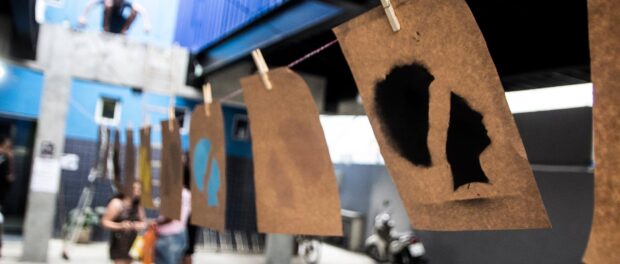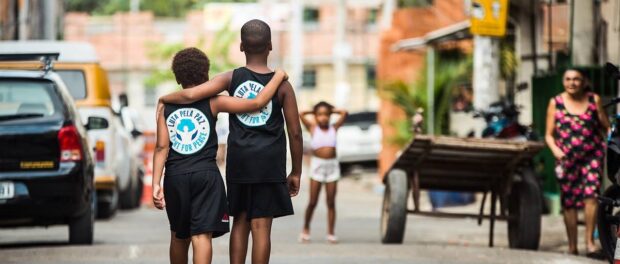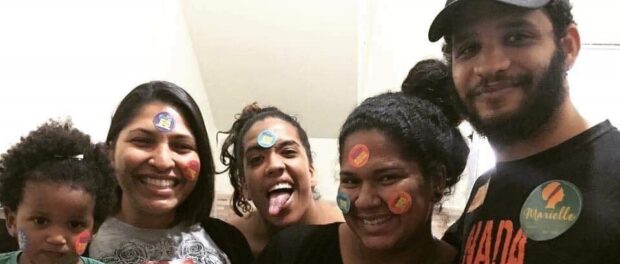
Handwritten by a child, a note sticking to the wall of a room at the NGO Fight for Peace in Maré draws attention: “I think that she did her part and died.” This was one of the many notes posted by children on the classroom’s bulletin board.
The death that the note refers to is that of Marielle Franco, the city councilor from Maré brutally assassinated along with her driver Anderson Gomes on March 14 this year. A black woman with a master’s degree, Marielle defended agendas rarely seen in the City Council, such as the rights of women (presiding over the Committee for the Defense of Women in the Rio de Janeiro City Council), black people, favela residents, the LGBT community, and all those who live under some form of oppression. She was the fifth most voted candidate, elected with more than 46,000 votes.
The day after Franco was assassinated, a group meeting was scheduled at Fight for Peace. The emotional meeting gave way to a passionate speech by social educator Gilson Jorge, 35 years old. It was at that moment that he realized that his students did not know who Marielle was—and that needed to change.
In this article, we will look at Jorge’s work as an educator at Fight for Peace and his initiative to teach students about Marielle Franco.
About Fight for Peace
Jorge runs eight youth groups at Fight for Peace, each of which has up to 30 students. His challenge is to work on personal development, social interaction, and commitment—while at the same time encouraging citizenship through the practice of martial arts.
As described by the organization, “Fight for Peace is an international nonprofit with the mission of fulfilling the potential of young people, working with them to prevent violence in the communities in which they live.” Founded in 2000 in Complexo da Maré, the organization developed a methodology called the Five Pillars, namely: boxing and martial arts, education, employability, support services, and youth leadership. Fight for Peace is now present in more than 25 countries.
Students, aged 7-29, divide their time between classes and martial arts in the morning, afternoon, or evening. The package of activities is complete, as everyone who participates in the sport is required to take social education classes as well. “It’s great to spend time with young people five days a week. I learn a lot as they grow,” says Jorge, who has been an educator for three years.
Education, a Family Tradition
Education has always been in Jorge’s DNA. He is close to completing his degree in Social Science—and from high school to his community’s pré-vestibular class (college entrance exam preparatory course) in Morro do Timbau favela, there’s been no lack of inspirational teachers. Along with education, [social] mobilization has been very important to Jorge through his participation in projects at Redes da Maré; since then, he has chosen the path of education.
Jorge has not always worked as a social educator at Fight for Peace. He initially joined the organization as a mentor in a special project to work on sociability and other issues with drug traffickers. Moreover, he played an important role in supporting 18-year-olds who wanted to improve their lives. The socially-oriented work of his sister, who coordinates the Women’s House in Maré, as well as that of his two educator cousins, were also important influences in continuing along the path of education.
Fernanda Mesquita, educator and personal development coordinator at Fight for Peace, speaks of Jorge’s importance as a social educator: “We needed a person like him to work with young adolescents. He’s a resident of Maré who has experience and skills, and who speaks the same language as them. He’s creative and always makes his classes very philosophical—and it works.”
Mesquita oversees Jorge’s work, which is quite autonomous. When Marielle was killed, the team got together and came up with an initial plan: to explore students’ reactions after the event and handle Marielle’s death based on these reactions. In this process of observation, the themes of racism and representation emerged.
From Mourning to Fighting
Jorge began researching, preparing, and exploring themes related to the Marielle Franco’s struggle. He questioned: why did she receive so few votes here in Maré? What kind of financial and communicational spaces did she have to present her ideas and gain the support of her peers, favela residents? He explored her list of bills, which addressed passenger harassment on public transit, the creation of birthing centers and nighttime childcare centers, and the legalization of abortion, among others. With this material, he prepared his first lesson about this woman—a black woman born and raised in Maré.
In the classes, which took place in the weeks after the assassination, representation of favela residents in the City Council was questioned. Regardless of ideological positions, everyone agreed on the impact of Marielle’s absence. The classes were also used to deconstruct fake news that had surfaced about her. According to Jorge, it was “an attack on democracy. For this reason, it’s very important to politicize our lives. I focus on relevant topics like this to develop skills in the classroom at Fight for Peace.”
But the initiative went further. Stemming from the lessons focused on Marielle Franco, in the wake of her death, themes of racism and representation have become a regular and ongoing part of Jorge’s classes.
His classes are not about Marielle’s death, but about the legacy that she has left behind.
Community journalist Thaís Cavalcante was born and raised in Nova Holanda, one of Maré’s favelas. While working as a community communicator in Maré, she decided to study journalism at university and believes in the power of information to change reality for the better.



